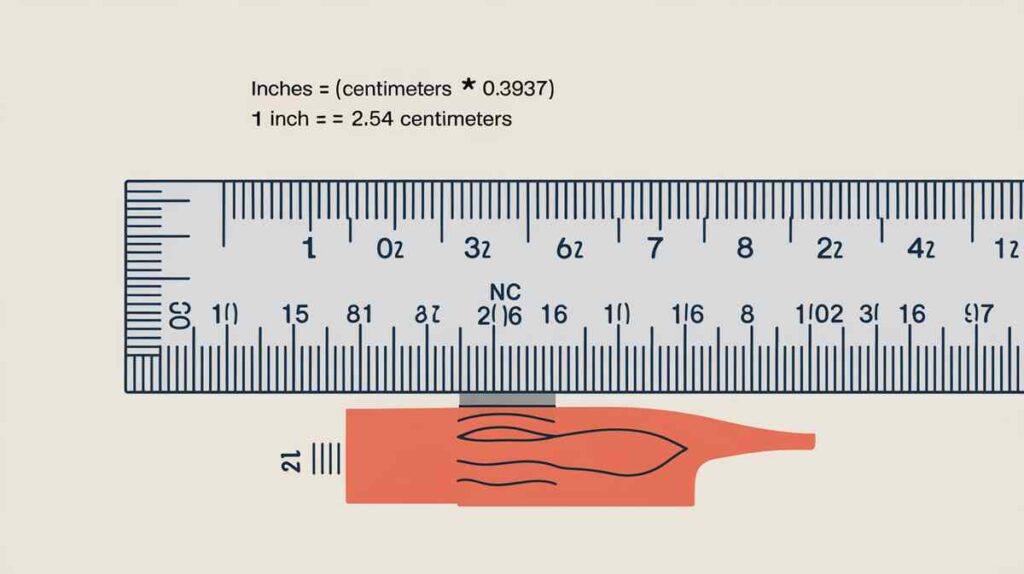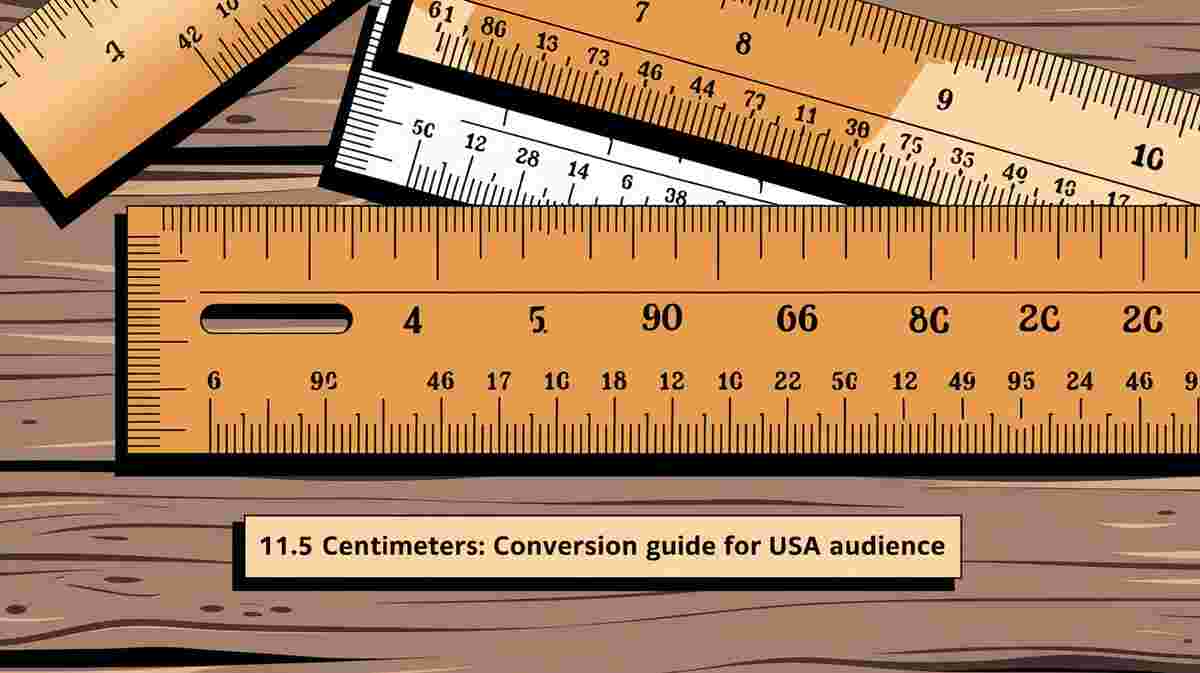11.5 centimeters is a length many people might want to convert, especially in countries like the USA, where the imperial system is commonly used. Converting measurements like centimeters to inches is essential for understanding distances, crafting projects, or making sense of global dimensions.
In this article, we will explain everything about converting 11.5 centimeters into inches. We’ll go over various examples, formulas, and even conversion tables to make the process simple for you.
11.5 cm to in | 11.5 Centimeters in Inches
When you want to convert 11.5 centimeters into inches, the formula is straightforward. By multiplying 11.5 cm by the conversion factor of 0.3937, you get 4.5276 inches.
In simpler terms, 11.5 centimeters equals 4.5276 inches.
For everyday purposes, you might round this to 4.53 inches. Understanding this basic conversion helps you get the right measurement for practical tasks like measuring a space or object.
The imperial system is used in the USA, and knowing how to work with both centimeters and inches can save time when using global products.
It’s crucial to understand that 1 centimeter equals approximately 0.3937 inches. This is the basic rule for any conversion to inches, and you can apply this formula to any length.
Read also: How Long Is 6 Inches?
All-One Unit Converter
One of the easiest ways to convert 11.5 centimeters to inches is by using a conversion calculator. Many online tools are designed to instantly convert cm to in by simply entering the number, like 11.5 cm, and press calculate. These calculators take the guesswork out of conversion and ensure accuracy.
When you use a conversion calculator, you avoid potential mistakes in manual calculations. These calculators are especially handy if you’re converting several values. They can also help with other common conversions, such as from centimeters to feet or even kilometers, which can be essential in various fields like travel, manufacturing, and daily life.
Approximate Values for 11.5 Centimeters in Inches
While exact numbers are important in some situations, it’s often useful to know the approximate values for measurements. The approximate value of 11.5 cm to inches is around 4.53 inches. This approximation works well when precision isn’t critical, like when estimating the length of an object for a quick measurement.
In certain cases, approximations help streamline processes. Whether measuring materials for a craft or getting dimensions for a room, knowing that 11.5 cm equals 4.53 inches offers a helpful guide for most practical needs. The conversion factor allows you to comfortably shift between measurement systems.
How Do We Convert Centimeters to Inches?

To convert centimeters to inches, you follow a simple formula:
cm × 0.3937 = in.
This conversion factor comes from the fact that 1 centimeter is equal to 0.3937 inches. For 11.5 centimeters, you simply multiply it by 0.3937 to get 4.5276 inches.
This process ensures accuracy when switching between measurement systems. Understanding the method allows you to calculate not just 11.5 cm but any length value in centimeters.
Whether converting for a personal project or a work task, having this knowledge ensures your measurements are always precise.
How Do We Convert Inches to Centimeters?
Just as you can convert centimeters to inches, it’s easy to reverse the process and convert inches to centimeters.
The formula for converting inches to centimeters is:
in × 2.54 = cm
This is because 1 inch is equal to 2.54 centimeters. For example, if you have a measurement of 5 inches, you can multiply it by 2.54 to get 12.7 centimeters.
This method is essential when working with items from the USA that are typically measured in inches. By knowing how to convert back to centimeters, you can compare sizes more effectively when dealing with global products or measurements.
Centimeter to Inches Formula and Conversion Factor

The formula to convert centimeters to inches is straightforward:
cm × 0.3937 = in
This conversion factor ensures that every centimeter is precisely converted to its equivalent in inches. For 11.5 centimeters, this formula shows the exact length in the imperial system, making it useful for anything from construction to art projects.
Having a clear grasp of this conversion factor means you can confidently handle any conversion to inches. Whether you’re using this formula for small items or larger measurements, its simplicity makes it reliable and accessible.
Centimeter to Inches Formulae
The centimeter to inches formulae are universal and can be applied to any value. Using the conversion factor, you can determine the length of any object in inches by multiplying its length in centimeters by 0.3937. For example, 11.5 centimeters equals 4.5276 inches, and this method can be used for any other measurement you might need to convert.
This understanding of the conversion formulae gives you the flexibility to quickly switch between measurement systems. Whether you’re traveling, measuring items, or just curious, knowing how to apply this formula ensures precision.
Example Problems on Centimeters into Inches Conversion
Let’s apply the centimeter to inches formula to a few real-world scenarios to see how it works in action. This section will give you a better understanding of how to use the conversion formula for everyday tasks.
These examples will cover a range of measurements and provide clear solutions that you can use in your work.
Example 1: Convert 23 Centimeters into Inches
If you need to convert 23 centimeters into inches, the formula is simple:
23 cm × 0.3937 = 9.0551 inches
This method ensures you get the precise result without any confusion. The process is identical for any measurement in centimeters, no matter how large or small.
Example 2: Transform 5.75 Centimeters into Inches
Using the same formula, 5.75 centimeters can be easily converted:
5.75 cm × 0.3937 = 2.2638 inches
The result can also be rounded to 2.26 inches for convenience.
Example 3: Transform 57.5 Centimeters into Inches
For a larger measurement, such as 57.5 centimeters, the conversion gives 22.6378 inches. This kind of precise conversion is essential when dealing with larger objects, where accuracy is critical.
Centimeters to Inches Conversion Table Around 11.5 Centimeters
For quick reference, you can use the following conversion table to find values around 11.5 centimeters:
| Centimeters | Inches |
| 10.85 | 4.27 |
| 11.15 | 4.39 |
| 11.5 | 4.53 |
| 11.85 | 4.67 |
This conversion table helps you quickly estimate values close to 11.5 cm, saving you time when you need a rough approximation.
Values Around 11.5 Centimeter(s)
When dealing with measurements, it’s useful to know values that are close to 11.5 cm. For instance, 11.3 cm converts to 4.44882 inches, and 11.7 cm converts to 4.6063 inches. Understanding how small differences affect conversions can be crucial for precision in many tasks.
By being familiar with values around 11.5 cm, you’re better equipped to handle slight variations in measurements without needing to recalculate each time.
Sample cm to Inches Conversions
Here are some additional examples of cm to inches conversions for reference:
- 5 cm equals 1.9685 inches
- 12 cm equals 4.72441 inches
- 15 cm equals 5.90551 inches
These examples provide clear insight into how various length values in centimeters convert to inches, offering a further understanding of how to use these formulas in daily life.
7 items that are approximately 11.5 cm in length:
Here are seven items that are approximately 11.5 cm in length:
- A standard toothbrush head from end to end.
- The length of an average pen cap.
- A credit card’s shorter side.
- The width of a compact disc (CD) case.
- A postcard’s shorter side.
- The length of a Sharpie marker cap.
- A small notebook width.
These items give a good sense of what 11.5 cm looks like in everyday objects.
Conclusion
Converting 11.5 centimeters to inches may seem complex at first, but with the right tools and understanding, it’s straightforward. Whether using a conversion calculator, applying the conversion factor, or referencing a table, this article has provided everything you need. Mastering these conversions ensures that you can work comfortably with both metric and imperial systems, which is particularly useful in the USA.

I’m Jean Scout, and I’m thrilled to be the person behind all the measurements and dimensions you’ll find here! With a love for numbers and practical solutions, I’ve made it my mission to break down complex conversions into simple, bite-sized pieces. Whether you’re figuring out room sizes or tackling tricky conversions, I’m here to make it easy and fun. Let’s get measuring together!

